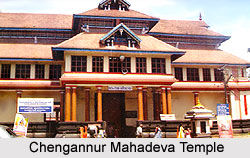 Chengannur Mahadeva Temple is one of the oldest temples in Kerala. It was earlier known as Nayanar Thiruchenkuntoor Kovil. The temple is dedicated to Lord Shiva. Chengannur Mahadeva is located at Chengannur, around 117 km from Trivandrum city, in Alappuzha district of Kerala. The reason is that it is one of the 108 Shakti Peethas dedicated to Goddess Parvati. The most important and unique feature of the temple is the Thriputharattu which is marked as a symbol of fertility. It is believed that the temple is also associated with the great epic Mahabharata. Chengannur has been derived form the word `Tiruchenkunroor.` The temple is one of the five ancient shrines and is also known as the Gateway to Sabarimala Temple.
Chengannur Mahadeva Temple is one of the oldest temples in Kerala. It was earlier known as Nayanar Thiruchenkuntoor Kovil. The temple is dedicated to Lord Shiva. Chengannur Mahadeva is located at Chengannur, around 117 km from Trivandrum city, in Alappuzha district of Kerala. The reason is that it is one of the 108 Shakti Peethas dedicated to Goddess Parvati. The most important and unique feature of the temple is the Thriputharattu which is marked as a symbol of fertility. It is believed that the temple is also associated with the great epic Mahabharata. Chengannur has been derived form the word `Tiruchenkunroor.` The temple is one of the five ancient shrines and is also known as the Gateway to Sabarimala Temple.
Legend of Chengannur Mahadeva Temple
The Chengannur Mahadeva Temple is associated with the Legend of Daksha. Parvati had sacrificed as Lord Shiva was insulted by her father. Lord Shiva infuriated by the course of events took the body of Sati over his shoulder and danced the rudra tandava or the dance of destruction. Lord Vishnu severed the body of Sati into pieces which scattered over different places. These places are called Shakti Peethas. Accordingly, it is believed that the reproductive organ of Goddess Sati`s body fell at the place where the temple is located. The Kamakhya Temple in Assam is also related with the same legend.
Architecture of Chengannur Mahadeva Temple
The Chengannur Mahadeva temple has been beautifully designed and decorated. The complex of the temple spreads over an area of six acres. The main shrine is conical in shape and copper plated. It has a circular sanctum. The architectural design of the temple has been developed by Perumthachan, the celebrated authority on architecture and carpentry. The intricate woodwork found in the Mukha Mandapam (main hall) of the temple is worth seeing. The main hall is located in the front of the temple. The delicate work in other Mandapams also adds charm and beauty to the temple.
The idol of Lord Shiva and Parvati installed in the temple faces the west direction. The idol of the goddess has been designed by using an alloy of five metals called Panchaloham. The Shiva lingam is covered with a gold plate with an image of Ardhanareeswara (the Shiva - Shakti manifestation of Lord Shiva). Apart from the main idol the temple also has many other idols installed in the temple like Lord Ganapathi, Dharma Shasta (Lord Ayyappan), Chandikeswaran, Neelagrivan, Ganga, and Nagar. A shrine for Lord Krishna is also located nearby.
Festivals of Chengannur Mahadeva Temple
Chengannur Temple celebrates many festivals and pujas during which the temple is beautifully decorated with lights and flowers.
Thriputharattu Festival
Thriputharattu is one of the main festivals celebrated in the temple. The festival is associated with the menstruation ceremony and is observed periodically in the temple. During this time the temple is kept closed for three days and worships will be offered to another image of the goddess in a different spot of the temple. On the fourth day the idol of the Devi is taken to a nearby river on the fourth day and Arattu (holy bath) is conducted. This ceremony is called Thriputharattu. Later the Devi rides an elephant and is taken back to the temple. During the festival the idols of Lord Shiva and Goddess Parvati are taken in procession around the temple three times. Then the Lord enters the shrine through eastern side and the goddess enters through the western side.
Varshikotsavam
This is another festival that is celebrated in Chengannur Temple. It is celebrated for 28 days. The festival begins on the asterism Thiruvathira of Dhanu masam (mid December-mid January) and ends on Thiruvathira of Makaram masam (mid January-mid February). During these three days many rituals are performed.
Thulasamkrama Neyyattu
This is the Ghee Abhishekam festival of the Chengannur Temple. This ceremony is conducted on every 1st day of Thulam (mid October-mid November). On this day 36 paras of ghee is showered on the `Shivalingam`. `Paras` is a measurement in Malayalam.
Besides these festivals, the Shivaratri Festival that falls in the month of February and March and the Chitra Pournami that falls in the month of April and May are also celebrated here with pomp and show.
Chengannur Mahadeva Temple is well connected with all modes of transport. The Chengannur Railway Station, on the Ernakulam - Kottayam - Kollam railway line, is the nearest railway station to reach Chengannur. Chengannur Bus Stand, a major KSTRC bus station in Alappuzha District, is just one kilometer from Chengannur Mahadeva Temple. Regular bus services are available from Aranmula, Thiruvalla (10 km), Pandalam, Pathanamthitta, and Trivandrum. The Cochin International Airport at Nedumbassery serves as the nearest airport to reach Chengannur.





















